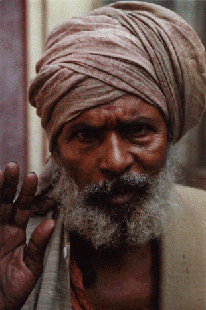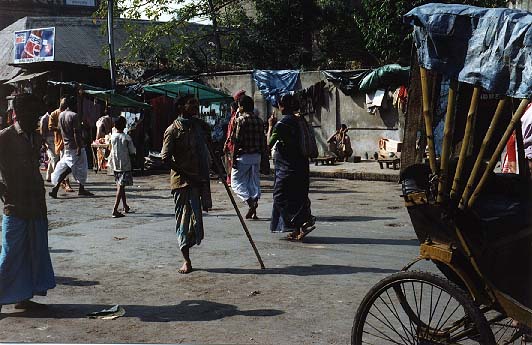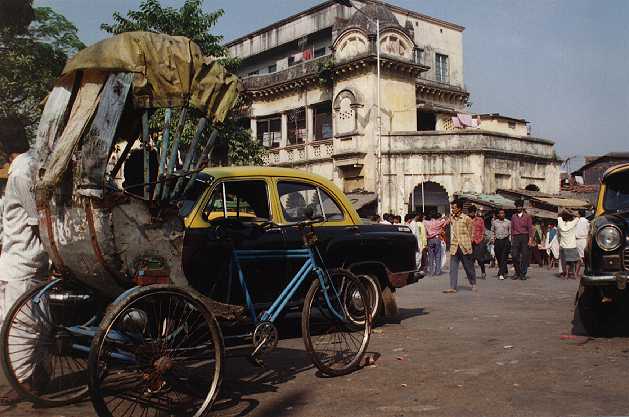 Saturday, November 23:
Saturday, November 23:
A relaxing day in Calcutta;
A rainy arrival in Madras
The Old Kenilworth didn't serve breakfast, of course, so by 8:30 or so we were at the New Kenilworth - a modern hotel down the street. They had a price fixe breakfast for three dollars a person, all you can eat buffet. It was more than we normally spent in India for food, but it was worth every rupee, since we could safely enjoy juices and fruit, along with everything else. Before we left the New Kenilworth, I made arrangements with the doorman to watch our bags for the afternoon - the Old Kenilworth would charge us RS50 per bag, which was outrageous. Before going to check out and get our packs, we first headed to south Calcutta to visit the great temple of Kali, the Kalighat.
Kalighat is the namesake of Calcutta, and is its most important temple. We reached it by taking Calcutta's metro - the only metro in all of India. It was eerily reminiscent of Boston's T system, except this one had the poetry of Rabindranath Tagore scrawled on the walls. From the Kalighat metro stop, we walked up and along Temple Road, which was filled with pilgrims and merchants who bought and sold goods of all kinds, from walking sticks to sunscreen to even small goats for sacrifice. The temple itself was surrounded by dozens of stalls which were linked together in a series of covered markets. Thousands of Hindus were queuing up to enter the sanctum sanctorum of the Temple. Since we weren't allowed there anyway, we entered through a minor gate which brought us into the main inner courtyard. We couldn't get inside any further, but we were at least in the middle of the action now.
 Sadhus were pacing all over the place, begging for alms and smoking enormous quantities of dope. Men sheathed in orange garlands stood transfixed in front of mini-shrines of Kali. Women marked each other with fresh tikas. Such commotion, in every direction. Photography was strictly limited to certain areas, but we still managed to get some shots of some pilgrims. I got a great close-up of a sadhu - I'm really pleased with it. We then saw a large crowd gathered around a small walled enclosure. A woman was pouring water onto three small goats which were tied to Kali shrines. A man walked in, wielding a large scimitar. It was time for the morning goat sacrifice. Susanne didn't want to have anything to do with it, and when I saw the size of the sword and heard the goats begin to shriek, I figure that was enough for me. I could leave the rest of it to my imagination.
Sadhus were pacing all over the place, begging for alms and smoking enormous quantities of dope. Men sheathed in orange garlands stood transfixed in front of mini-shrines of Kali. Women marked each other with fresh tikas. Such commotion, in every direction. Photography was strictly limited to certain areas, but we still managed to get some shots of some pilgrims. I got a great close-up of a sadhu - I'm really pleased with it. We then saw a large crowd gathered around a small walled enclosure. A woman was pouring water onto three small goats which were tied to Kali shrines. A man walked in, wielding a large scimitar. It was time for the morning goat sacrifice. Susanne didn't want to have anything to do with it, and when I saw the size of the sword and heard the goats begin to shriek, I figure that was enough for me. I could leave the rest of it to my imagination.

We briefly explored the market stalls surrounding the temple before crossing the street to Mother Theresa's Home for the Dying Destitute, a hospice for Calcutta's dalit population. Susanne wanted to make a donation, so we entered and found a room with several dozen beds, most of which were filled with emaciated, gravely ill Untouchables. A group of sisters told Susanne that they couldn't accept traveler's checks here, so we had had to spare cash rupees in order to give. After leaving a donation, we returned to the Old Kenilworth to check out, making a quick stop at the local KLM office to reconfirm our flights to Amsterdam and Washington. We dropped our bags at the New Kenilworth and then walked through the Chowringee neighborhood to the maidan, Calcutta's central park.
 Our first stop was St. Paul's Cathedral. Not an impressive cathedral by European standards, but a fascinating place nonetheless, especially considering its location in the heart of south Asia. So we made our way to our next destination, across the street at the southern end of the maidan - the Victoria Memorial. The memorial is a massive marble monster of a tribute to the good queen and Empress of India, who died in 1901 after decades of British rule. It reminded me of an English version of the Reichstag or something. We made a circuit around the memorial, trying to stay cool under the hazy, oppressive Calcuttan sun. Eventually, we retreated inside the memorial, where we were moderately entertained by a lackluster museum on the rise and fall of the British Raj.
Our first stop was St. Paul's Cathedral. Not an impressive cathedral by European standards, but a fascinating place nonetheless, especially considering its location in the heart of south Asia. So we made our way to our next destination, across the street at the southern end of the maidan - the Victoria Memorial. The memorial is a massive marble monster of a tribute to the good queen and Empress of India, who died in 1901 after decades of British rule. It reminded me of an English version of the Reichstag or something. We made a circuit around the memorial, trying to stay cool under the hazy, oppressive Calcuttan sun. Eventually, we retreated inside the memorial, where we were moderately entertained by a lackluster museum on the rise and fall of the British Raj.
The museum grew old fast so we started the walk north through the maidan up to Sudder Street, which was where the Fairlawn hotel was located. The maidan was an odd place - wide gravel paths, fields of grass, gardens, memorials, and fountains, with highrises looming in the distance. Susanne and I agreed that it was a dusty and humid clone of Grant Park in Chicago. Very strange. As we walked along, we passed what appeared to be a military ceremony welcoming some brigadier general as commander of some division. It seemed quite British, with all of the pomp and circumstance, though one group of soldiers were parading around on short stilts. Further afield, we saw match after match of cricket. Whether it was a bunch of ragtag kids using tree limbs as bats, or a club of young professionals in freshly pressed uniforms, the cricket matches dominated the activities on the maidan. I just wish I understood how the bloody game was played.
We crossed east back into the northern end of Chowringee to reach Sudder Street. After a brief search, we found ourselves back at the Fairlawn. Since we couldn't stay, we figured we'd at least stop by for some tea or even lunch. After the concierge from the night before recognized us, we were soon greeted by the hotel's owner, Violet, and her husband. She profusely apologized for the mixup. She then said if she had been there the night before, she would have physically prevented us from going to the Old Kenilworth. "It's a disgrace," she lamented. "50 years ago, it was a jewel of a hotel, but when the owner died, her daughter Joyce inherited it and hasn't bothered to fix any of it since. She's ruined it by letting it fall apart. A disgrace." We talked for a while over a cold drink, and she then suggested we stay for lunch, which would be served in about 20 minutes (a uniformed waiter would announce lunch by banging a small gong - how quaint).
At the sound of the gong, we sat with an English couple from Yorkshire who had been traveling around India for two months. They had just returned from a lovely stay at the beach resort of Kovalam, on the southwestern coast in Kerala state. They strongly suggested we go if we got the chance. We were then joined by a fascinating older gentleman from Ireland named Andy. He looked as if he were in his late 70s, his face weathered and unshaven - oddly reminiscent of Timothy Leary in his last year. Andy had ben traveling to India regularly since 1964, and talked at length about Varanasi and the cities of Tamil Nadu. Susanne mentioned she was from Chicago, and Andy said that he had worked with Frank Lloyd Wright in the 1940s. He had traveled the US extensively (probably more than we had), back in the days when "you could hitchhike your way for weeks at a time through Arizona, trading places with the driver and taking shifts while one of you would steer while the other would hold the loaded pistol - just in case..."
Andy was a great fan of the States: "Even though it's changed much over the last 50 years, it's still a place where strangers will help another person in need when they really need it." This, he added, was quite unlike India, where he thought, that there was little regard for human life, sadly. He cited the suffering of street lepers in Calcutta, and how they are ignored by everyone as an example. Andy also discussed the short-sightedness of Jawaharlal Nehru and Muhammad 'Ali Jinnah when they decided to partition the subcontinent into Hindu India and Muslim Pakistan. "It was the greatest and most foolish political tragedy of the century," he lamented. "India has never recovered from it. It probably never will. They were arrogant men and their countries paid for it." Lunch, desert, and tea were long gone by this point, but Andy kept talking. He was wise and reflective on history, and loved to argue over the course of events - I respected that. As we finally departed, he said, "Andy, Susanne, my dear, if we ever meet again, and I hope we do, I may no longer be able to remember your names, but I promise that your faces and this conversation will be committed to memory. I promise you that." Upon these words, he put on his hat and walked away.
We lingered a while longer at the Fairlawn, sitting in the sunny garden courtyard. I couldn't believe we were in Calcutta. I had expected a city as dismal as Delhi, but instead, I've found it to be a relaxed, cultured, and dignified place, with wide boulevards and green gardens. Of course, poverty ran rampant around the city, but yet there was still something in the air which had everyone smiling. I always thought the nickname "The City of Joy" was a joke. It certainly isn't.
Back at the New Kenilworth, we picked up our bags and taxied over to Dum Dum Airport (whose name comes from the local Dum Dum Barracks, where the infamous dumb-dumb bullets were made). Leaning over to pull my backpack out of the trunk, I hit my head on the trunk door, right on a rusty corner. Good thing my tetanus shot was up to date, because it was a nasty gash. We then entered the domestic terminal - a clean, modern facility that was by far the nicest airport in India. Check-in and security was a breeze, and there was plenty of time for me to wash clean my new wound. We then wrote in our journals as we waited, until the plane was ready to depart. We left on time, just before 6pm.
It was pouring rain when we arrived in Madras, just after 8 o'clock. Unlike the rest of the subcontinent, which had tried out the month earlier, Madras and Tamil Nadu state were just hitting the peak of their second monsoon of the season, averaging about half an inch of rain a day. Because of the storm, the taxi drivers all wanted to charge us an extortionate RS250 for the trip to our hotel, the Broadlands. There wasn't much we could do about it, so we grabbed a cab and headed north. It rained on and off throughout the drive, but when we pulled into the street that led to the Broadlands, the driver told us to get out and walk because the street was too flooded for him to drive down it. Soaked to the bone, we slogged our way through the running rapids that had once been a street til we entered the hotel.
Once there, we were lucky in the sense that we got the last available room. Then again, we were unlucky in the sense that the rooms improved as the number of the room increased, and we were stuck with Room 1. It was dirty, damp, and the toilet wreaked. It was only five dollars for the night, but I was beginning to question how LP goes about choosing hotels for recommendation. Susanne and I were both in a pissy mood from the rain and the lousy accommodations. We decided then and there to get outta Dodge as early as possible the next day and head south to Mahabalipuram, the small fishing village and beach resort famous for its 7th century temples. It may be raining there, we figured, but at least we might get some peace and quiet.
Next Entry: Madras to Mahabalipuram
Take me back to the journal index.
Take me back to Andy's Waste of Bandwidth.



EdWeb: Exploring Technology and School Reform, by Andy Carvin. All rights reserved.
 Sadhus were pacing all over the place, begging for alms and smoking enormous quantities of dope. Men sheathed in orange garlands stood transfixed in front of mini-shrines of Kali. Women marked each other with fresh tikas. Such commotion, in every direction. Photography was strictly limited to certain areas, but we still managed to get some shots of some pilgrims. I got a great close-up of a sadhu - I'm really pleased with it. We then saw a large crowd gathered around a small walled enclosure. A woman was pouring water onto three small goats which were tied to Kali shrines. A man walked in, wielding a large scimitar. It was time for the morning goat sacrifice. Susanne didn't want to have anything to do with it, and when I saw the size of the sword and heard the goats begin to shriek, I figure that was enough for me. I could leave the rest of it to my imagination.
Sadhus were pacing all over the place, begging for alms and smoking enormous quantities of dope. Men sheathed in orange garlands stood transfixed in front of mini-shrines of Kali. Women marked each other with fresh tikas. Such commotion, in every direction. Photography was strictly limited to certain areas, but we still managed to get some shots of some pilgrims. I got a great close-up of a sadhu - I'm really pleased with it. We then saw a large crowd gathered around a small walled enclosure. A woman was pouring water onto three small goats which were tied to Kali shrines. A man walked in, wielding a large scimitar. It was time for the morning goat sacrifice. Susanne didn't want to have anything to do with it, and when I saw the size of the sword and heard the goats begin to shriek, I figure that was enough for me. I could leave the rest of it to my imagination.  Saturday, November 23:
Saturday, November 23:
 Our first stop was St. Paul's Cathedral. Not an impressive cathedral by European standards, but a fascinating place nonetheless, especially considering its location in the heart of south Asia. So we made our way to our next destination, across the street at the southern end of the maidan - the Victoria Memorial. The memorial is a massive marble monster of a tribute to the good queen and Empress of India, who died in 1901 after decades of British rule. It reminded me of an English version of the Reichstag or something. We made a circuit around the memorial, trying to stay cool under the hazy, oppressive Calcuttan sun. Eventually, we retreated inside the memorial, where we were moderately entertained by a lackluster museum on the rise and fall of the British Raj.
Our first stop was St. Paul's Cathedral. Not an impressive cathedral by European standards, but a fascinating place nonetheless, especially considering its location in the heart of south Asia. So we made our way to our next destination, across the street at the southern end of the maidan - the Victoria Memorial. The memorial is a massive marble monster of a tribute to the good queen and Empress of India, who died in 1901 after decades of British rule. It reminded me of an English version of the Reichstag or something. We made a circuit around the memorial, trying to stay cool under the hazy, oppressive Calcuttan sun. Eventually, we retreated inside the memorial, where we were moderately entertained by a lackluster museum on the rise and fall of the British Raj. 

